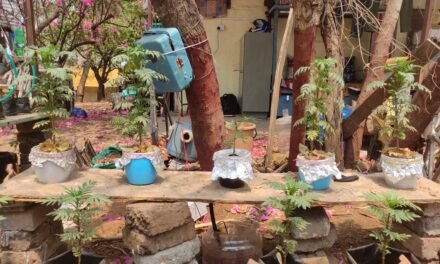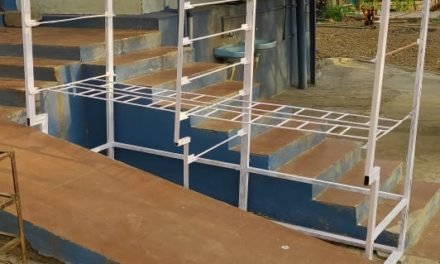Date 20/01/2020 to 18/03/2020
Project title :- Energy efficient to polyhouse automation design,installation and testing
Information of polyhouse
To collect the basic information about the polyhouse by using research paper.
A Polyhouse is a building where plants are grown. Polyhouses are often used for growing flowers, vegetables, fruits, and tobacco plant. Basic factors affecting plant growth are sunlight, water content in soil, temperature, etc. These physical factors are h to control manually inside a Polyhouse and a need for automated design arises. Automatically controlling all the factors that affect plant growth is also a difficult task as it is expensive and some physical factors are inter-related, for example, temperature and humidity are related in a way when temperature raises humidity reduces therefore controlling both together is difficult. Because the temperature and humidity of Polyhouse must be constantly monitored to ensure optimal conditions, a wireless sensor network can be used to gather the data from point to point.
A graphical user interface (GUI) is unified for the ease of operations by the farming community. System also allows transmission of process parameters, including emergency alarm signals via e-mail client server or alternatively sending a SMS on a mobile phone. A conventional chat has also been integrated with the GUI to add vibrancy to inter-user communication. This feature can be embedded in upcoming 3G mobile technology. Simulations and video tutorials can also be integrated in the web server for teaching the farming community. Such integrated approach greatly widens the socio-economic possibilities for farmersIn last decade, ground water level has been decreasing day by day due to unplanned use of water and lack of rains.
Irrigation system improves the yield and quality of crops. Also, saves huge amount of water. In present micro irrigation system such as drip and Sprinkler irrigation, water being provided directly to root zone of plants and this results in water saving and labor work savings. Indian farmers face several challenges such as availability of water, small land holding, poor yield due improper methods of farming, natural phenomena such as rainfall and lack of knowledge of modern methods of agriculture. Recently, for low cost production new intelligent systems are being developed in agricultural.
To growing multiple crops and for making efficient use of land and resources, plant factory provide high yield of crop in agriculture. Main source for Plant growth is that surrounding climates such as humidity, temperature, CO2 and light intensity and these factors are very important to be monitored and maintained to increase yield of crop. The wireless sensors networks (WSN) perform a specific task to defined as the collection of sensor nodes that and they are representing one of the technological solutions to automates and improve the management of crops.
Polyhouse farming is an alternative new technique in agriculture gaining foothold in rural India and can be successfully employed for niche areas of agriculture. A typical Poly house (metal structure covered with Polythene) is from 400 – 10,000 m2; this makes them suitable for farmers with small land holding also. A low – to medium – cost Poly house could cost between Rs.125 to Rs.500 per square meter in India, whereas a highcost, fully-automated Poly house costs Rs. 2,000 per square meter. Most Indian farmers cannot afford such high costs but group of farmers and co-operatives can use such systems. Farmers do require expert guidance to use this new technology of Poly house farming.
This methodology of farming reduces dependency on rainfall and makes the optimum use of land and water resources; typical gains may be three times those of traditional farming. Poly house farming/ shelter farming is an alternative new technique in agriculture gaining foothold in rural India. It reduces dependency on rainfall and makes the optimum use of land and water resources. Potentially, poly house farming can help the farmer generate income round the year growing multiple crops. This also helps them spread their risks. Poly house farming enables cultivation of crops that can give maximum yield on specific days (e.g. roses
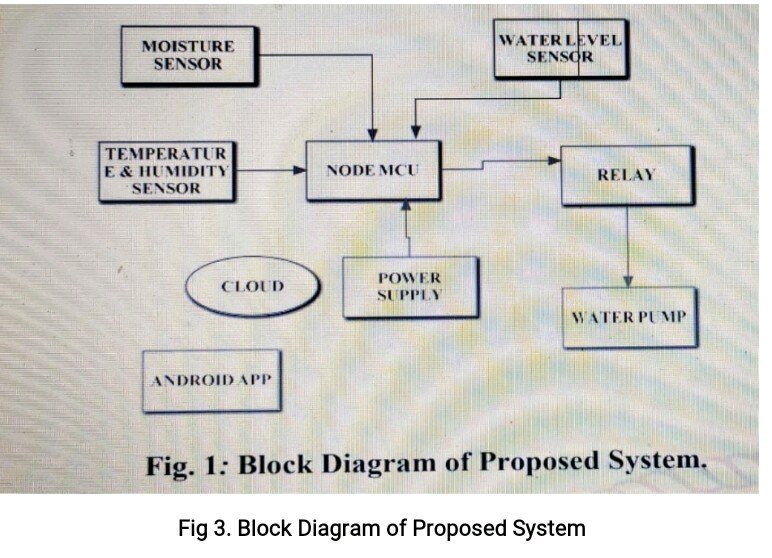
Internet of Things (IoT) is the network of physical things embedded with electronic circuits, sensors, software and network connection which enables these things to exchange data from one another. IoT is the fusion of the digital and physical world. In a world of IoT, millions of things or devices will be interconnected and uniquely identified on the Internet. The Internet of Things allows objects to be sensed and controlled remotely across existing network infrastructure, creating opportunities for more direct integration between the physical world and computer based systems, and resulting in improved efficiency, accuracy and economic benefit. In near future, IoT is expected to provide many more services like advanced connectivity of physical objects over a wide network and also many applications. Node-MCU is an open source IoT platform. It includes firmware which runs on the ESP8266 Wi-Fi SoC from Es press if Systems, and hardware which is based on the ESP module. The term “Node-MCU” by default refers to the firmware rather than the dev kits. Th uses the Lua scripting language. It is based on the eLua project, and built on the Es press if Non SDK for ESP8266. It uses many open source projects, such as luacjson, and spiffs.
The Node Micro-Controller Unit) is an open source s hardware development environment that is built around a very inexpensive System-oncalled the ESP8266. The ESP8266, designed and manufactured by Es press if Systems, contains all crucial elements of the modern computer: CPU, RAM, networking (wi-fi), and even a modern operating system and SDK. When purchased at bulk, the ESP8266 chip costs only $2 USD a piece. two in the relay pictured. The armature is hinged to the yoke and mechanically linked to a moving contact or contacts.
It is held in place by a spring so that when the relay is de-energized there is an air gap in the magnetic circuit. In this condition, one of the two sets of contacts in the relay pictured is closed, and the other set is open. Other relays may have more or fewer sets of contacts depending on their function. The relay in the picture also has a wire connecting the armature to the yoke. This ensures continuity of the circuit between the moving contacts on the armature, and the circuit track on the Printed Circuit Board (PCB) via the yoke, which is soldered to the PCB.
Water Level Sensor
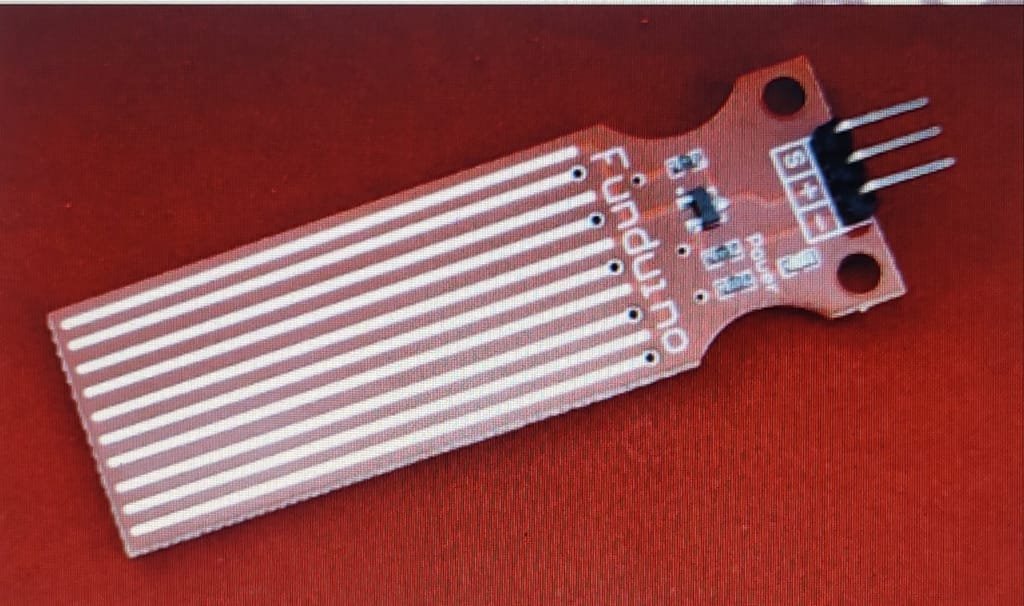
Fig 2: Diagram of Water Level Sensor
The sensing probe element consists of a special wire cable which is capable of accurately sensing the surface level of nearly any fluid, including water, salt water, and oils. The sensor element is electrically insulated and isolated from the liquid into which it is inserted, and will not corrode over time. Unlike, other sensors, the measurement range is adjustable from a few centimeters to over several meters. The reading is reported back as an analog voltage ranging from 0V to 3V where 0V represents the sensor not being submersed, and 3V represents the maximum water level. The water level sensor can be easily calibrated to nearly any range and any fluid in the field with the use of two buttons. One button records the minimum fluid level (0V level), and the the other button records the maximum fluid level (3V level). After being calibrated, the sensor will return a value of 0 to 3 volts linear with the liquid level.
The water level sensor is compact, low cost, low power, easy to use, and can take an accurate reading in less than a second. The sensor has an easy to mount water resistant enclosure. The cable can be made taut averages the water content over the entire length of the sensor. There is a 2 cm zone of influence with respect to the flat surface of the sensor, but it has little or no sensitivity at the extreme edges. The Soil Moisture Sensor is used to measure the loss of moisture over time due to evaporation and plant uptake, evaluate optimum soil moisture contents for various species of plants, monitor soil moisture content to control irrigation in greenhouses and enhance bottle biology experiments.
Stage 3 :
programing of polyhouse automation system:
In this stage i get the information about polyhouse automation programming system which is useful to controlling the fan and water motor in polyhouse with specific time.
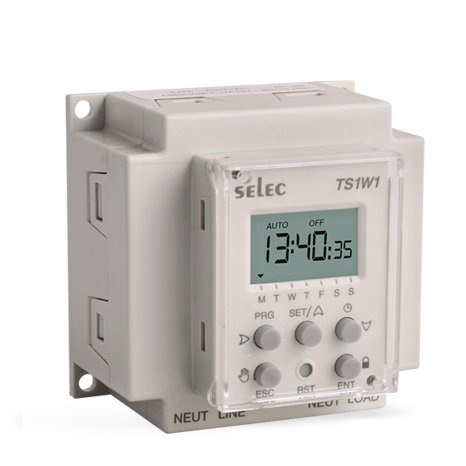
Fig: Selec TS1W1
The Detail Information about Selec TS1W1
| Display Type | Text LCD (Without Backlight) |
| Relay Contact | 1 NO and 1 Neutral |
| Operation Period | 1 Week |
| Features | 50 ON-OFF Steps Per Day, Indications: Auto Manual, Holiday, Relay Status, Day Of Week, Programming mode. |
| Supply Voltage | 230V AC, 110V AC |
| Size | 60 x 60mm |
| Mounting Type | Wall Mount |
| RTC Accuracy | 15 Minutes A Year |
| Certification | CE |

Fig. Programming on SELEC TS1W1
Stage 4: Fan and Pad cooling system in polyhouse
The AC system is comprised of two units of 1.1 KW AC motors, means total 2.2 KW/ hour of consumption. The system runs 6-8 hours/ day which means it consumes up to 15-16 KW of electricity per day. If we calculate it in terms of money it is approximately 150 rupees per day which is very huge amount. To minimize this cost of ventilation we need to switch that system on DC with solar powerWe have derived the torque of existing 1.5 HP AC motor by making rope brake dynamometer for torque test which was found to be 7.16 Nm.
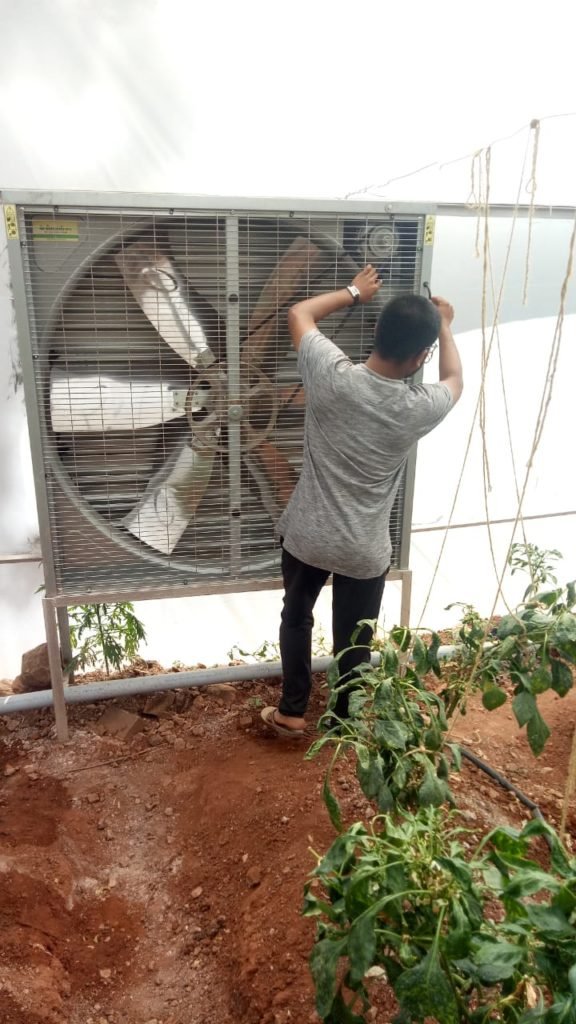
Fig.Working on Cooling Fan in polyhouse.
In this stage sincerity and hard work of our professionals, we have carved a niche for ourselves in this domain by offeringWater Distribution ForCooling Pad service. I offered system includes pad media, distribution pipe, water supply, sump, pump, gutter, and bleed-off line. The provided system is highly known for its corrosion resistance and durability. This system is fabricated using heavy duty, polyvinyl chloride pipe, GI pipe that makes it highly functional. Moreover, these pipes are connected with steel flange, to attach the external piping.
The Evaporative Cooling Pads are made from a specially formulated cellulose paper, impregnated with insoluble anti-rot salts, stiffening saturates and wetting agents to provide maximum cooling. It can be used for many different cooling purposes but is particularly suitable for cooling of livestock buildings and greenhouses.
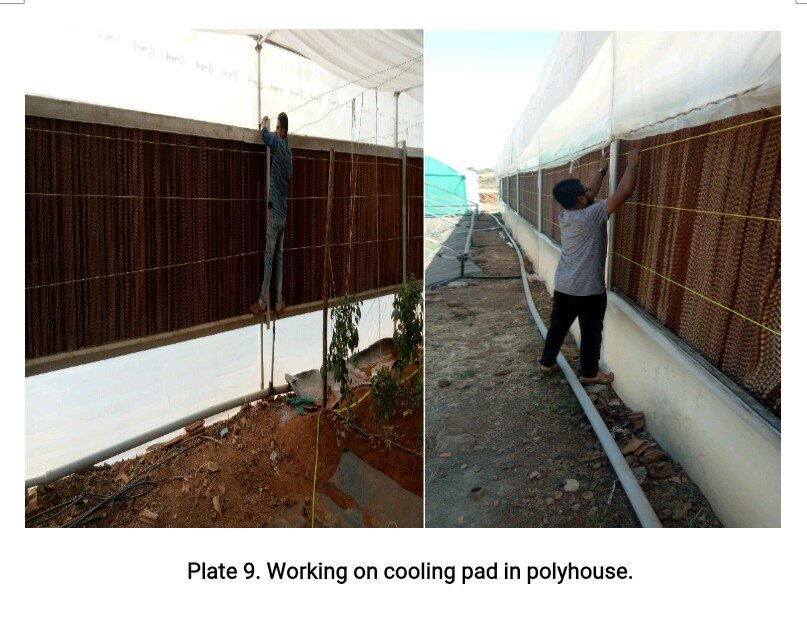
This Cooling padconsists of specially impregnated and corrugated cellulose paper sheets with different flute angles, one steep (60 degree) and one flat (30 degree) that have been bonded together. This unique design yields a cooling pad with a high evaporation efficiency while still operating with a very low pressure drop. In addition scaling is kept to a minimum and no water carryover occurs due to the fact that the water is directed to the air inlet side of the pad. This is where most of the evaporation takes place. The impregnation procedure for the cellulose paper ensures a strong self-supporting product, with high absorbance, which is protected against decomposition and rotting and therefore increasing longevity.
The distribution pad constitutes a vital part of a complete system and should always be ordered in combination with Cooling Pad. Placed on top of the cooling pad it ensures a uniform supply of the water to the cooling pad and minimizes the risk of dry spots.
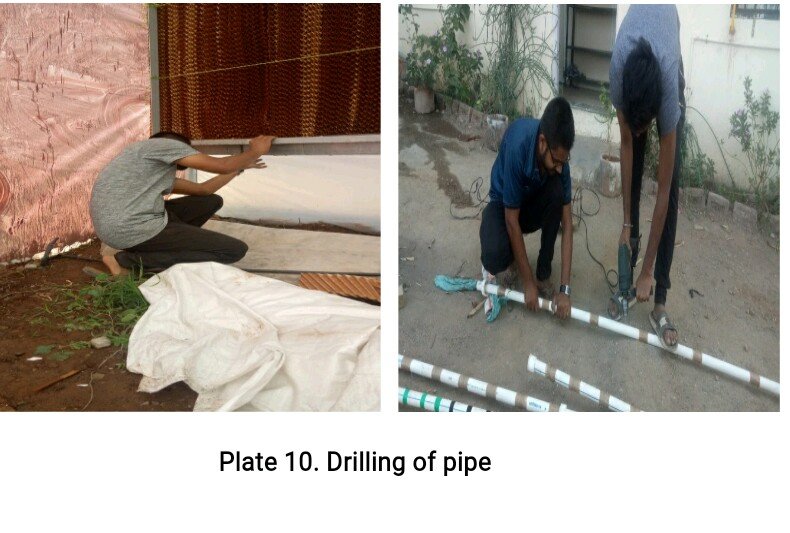
Heigh evaporation efficiency
Superb wetting properties
Low pressure drop when wet, leading to lower operating costs
No water carry-over
Low scaling
Self-cleaning
Strong and self-supporting
Long life time
Low running costs
Quick and easy to install
Environmentally friendly
Consist high quality
Technical Specifications
| Specifications | Value |
| Standard Height | 1000mm,1500mm,1800mm,2000mm. |
| Standard Width | 600mm |
| Standard Depths | 100mm,150mm,200mm and 300mm. |
During summer periods, high temperature values that are being formed in polyhouse can greatly influence the efficiency of production workers and also decrease the productivity of plants grown there. A greenhouse production without the cooling systems can be sustained at the desirable level by imposing summer restrictions in the areas with warm climate, and by starting cooling in the areas with cold climate. A statement can be made regarding both utility and efficiency of fan-pad cooling systems that they tend to go up in the areas with low relative air humidity.
The present study has been carried out in order to either prove or disprove this statement. We have attempted to create a map of internal greenhouse temperature distribution via determining the system’s efficiency. As a result of this study, it was determined that since air temperature and relative humidity in the air tend to decrease during summer months by using fan-pad cooling system, temperatures in the greenhouse can be consequently lowered down to 10-12°C. Statistical analysis revealed remarkable differences between the temperatures at various points in greenhouses observed. Even water delivery through distribution pipe will be ensured. Slow water contamination and efficient water flow, to achieve temperature 2 oC below ambient temperature ,45% RH.
- Stage 5:
In this stage Study the solar system in polyhouse Photovoltic (PV) systems are commonly used solar panel systems in the UK. Photovoltaic systems convert sunlight directly into electricity. Solar cells are made of semiconductors, such as silicon, whichabsorb the sunlight and electricity. Solar cells are connected electrically and packed together in a frame, convert it into commonly known as a solar panel. When you connect multiple solar panels together, they form a solar array. And, finally, when you add the cabling, brackets, inverter, and so forth, the entire system forms your solar panel system.
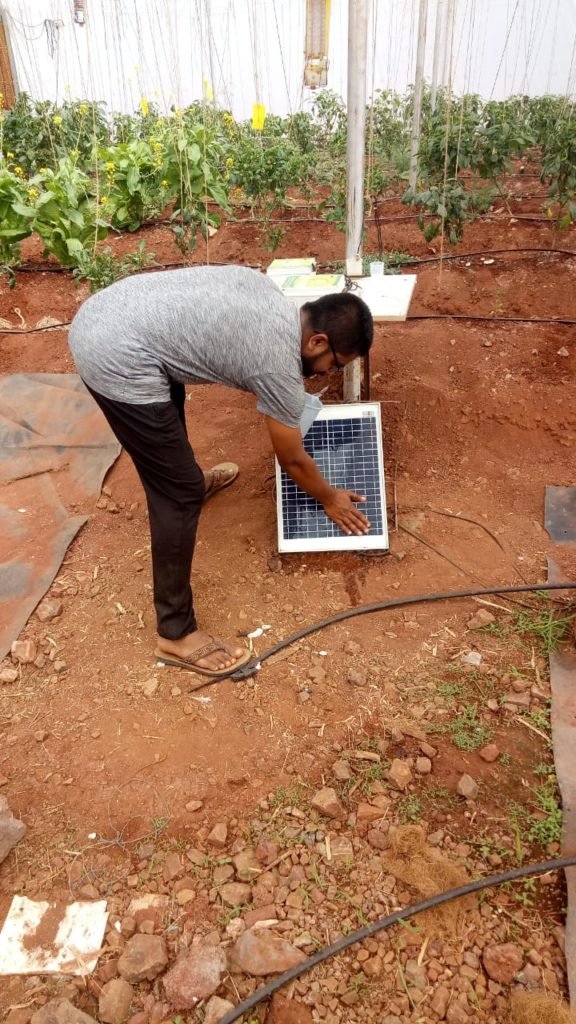
A typical commercial solar module has an efficiency rating of 1
5-20%. One important challenge of the PV industry is to improve solar module efficiency, and at the same time, keep down the cost per cell.
Naturally, there are many factors that can affect the efficiency of your solar panels, from the type of solar panel to angling, and seasonality.
The chart below shows the average energy output produced throughout the year by a south-facing 4kWdomestic solar panel system on a roof angled at 40 degrees. As you can see, solar panels are most efficient during the summer months, but still produce enough energy to power 33-51% of a home during the winter period.
The power of solar panels is measured in kilowatt hours. When placing your cursor over the columns in the chart, individual figures are displayed. To find the average energy output,add the minimum figure and the average figure. To find the maximum output, add all three together.
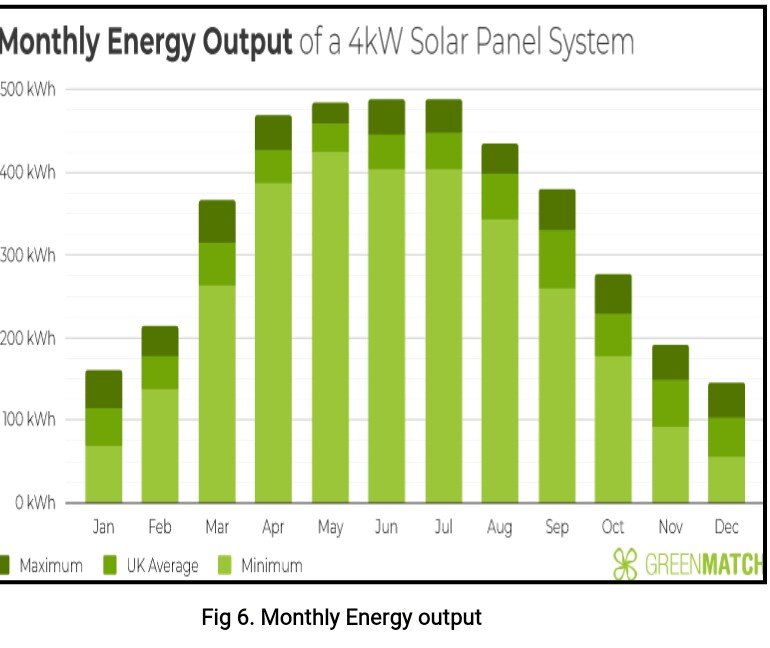
Stage 6:
measure the temperature and Humidity of polyhouse
In this stage study the inside and outside temperature and humidity of polyhouse,the three devices are used Thermometer,Bluetooth connect automatic device,Automatic devices,
THERMOMETER READINGS

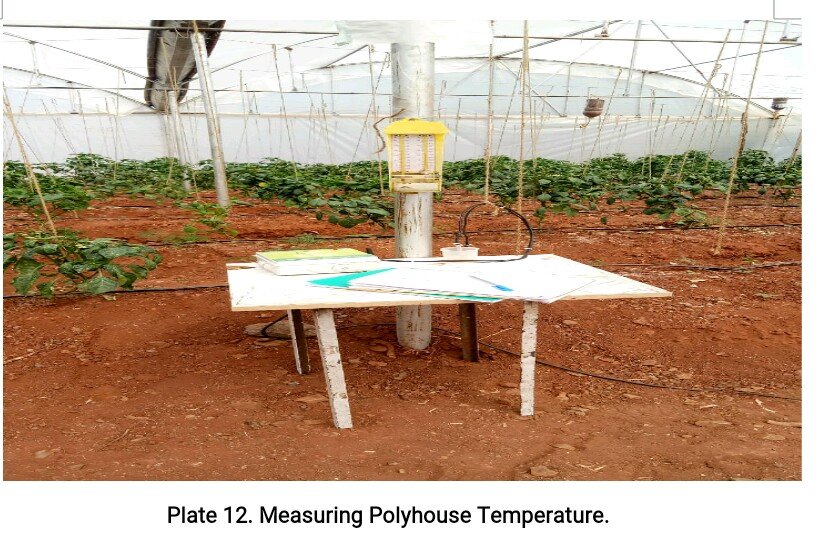
- Thermometer Reading:
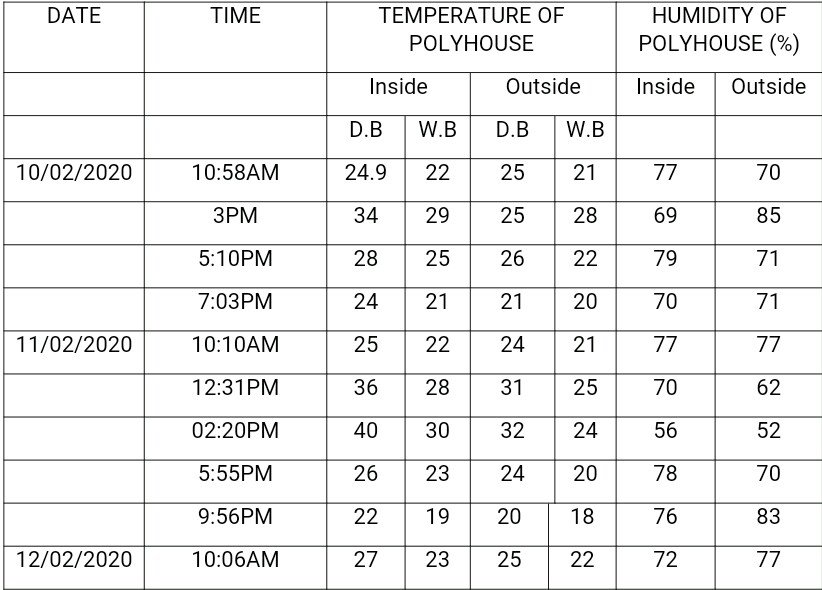
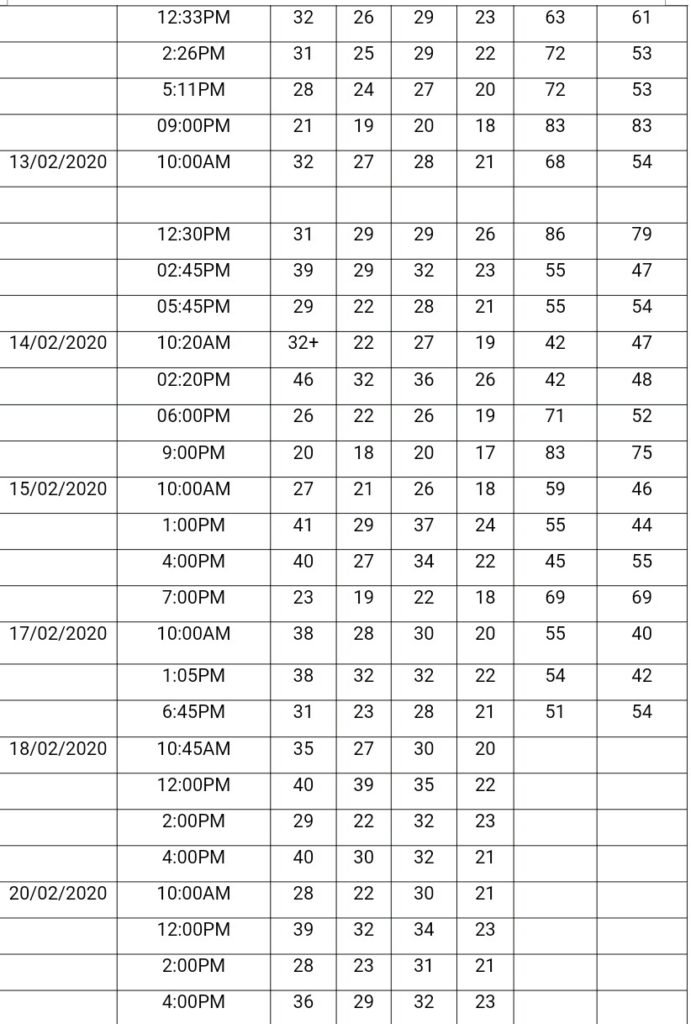
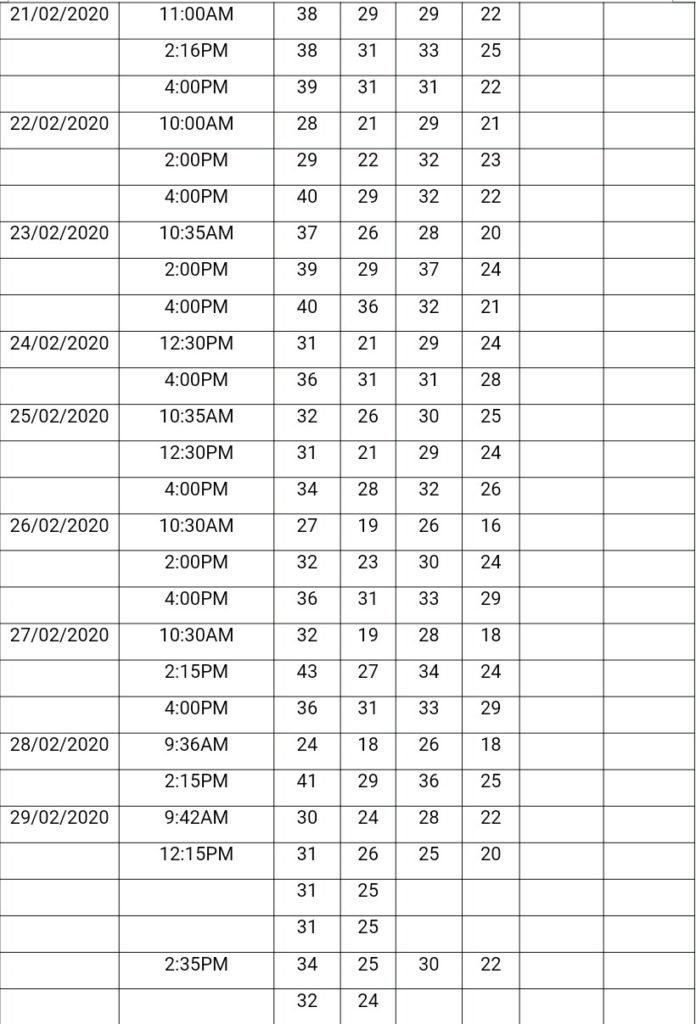
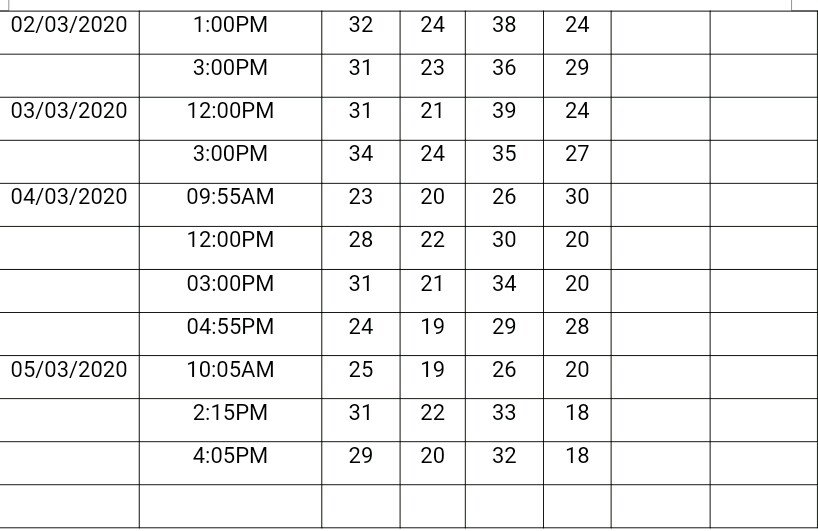
Farm Auto Readings(Bluetooth Readings)
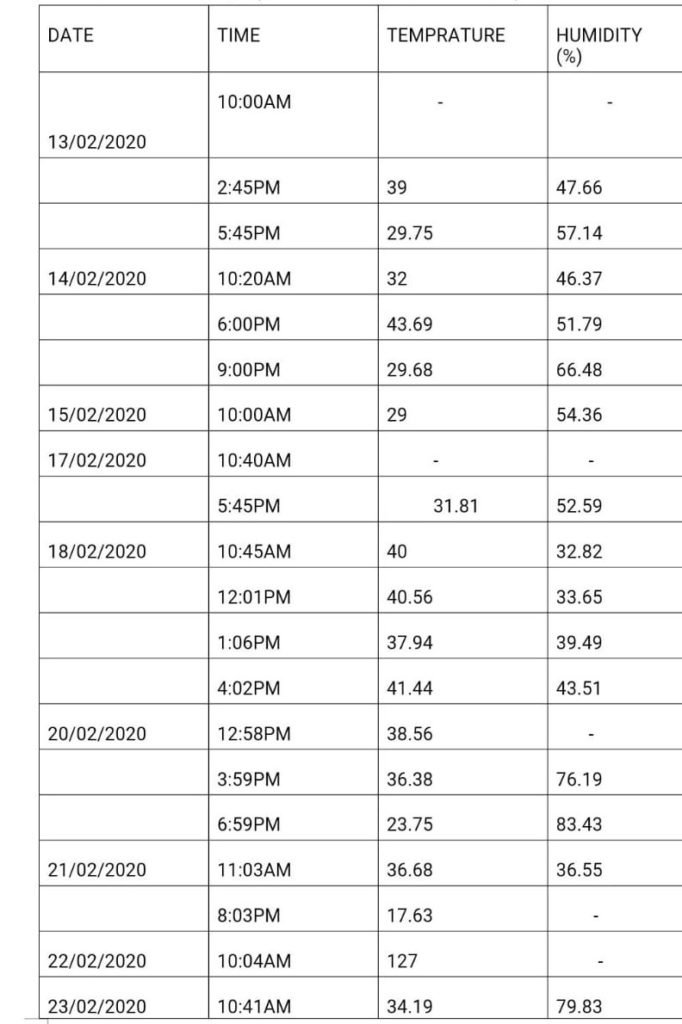

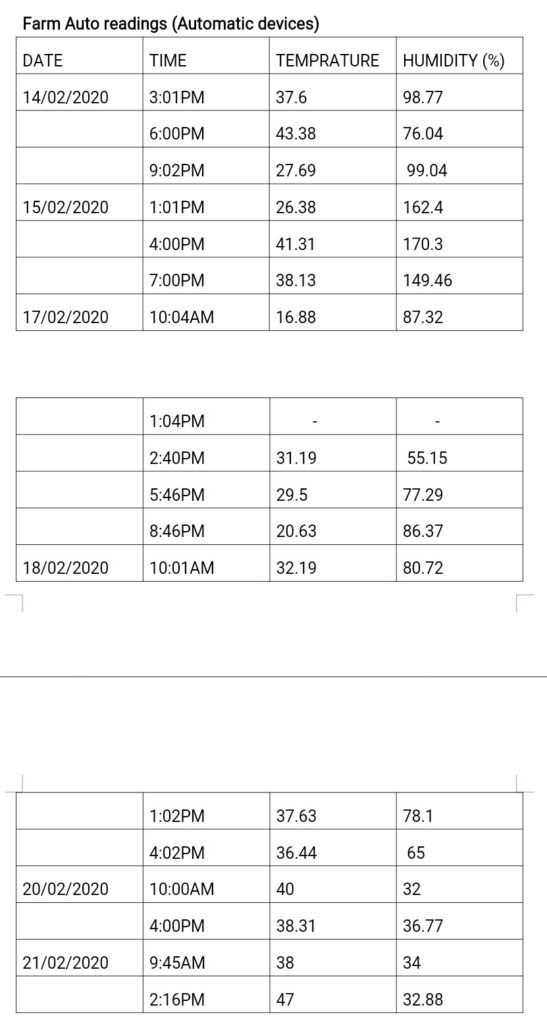
1.INTRODUCTION
A CASE STUDY OF CLIMATE CHANGE AND FOGGER COOLING SYSTEM IN POLYHOUSE

Fig.Polyhouse
1.INTRODUCTION
If increased polyhouse gas emissions from human activity are causing climate change, then how do we reduce those emissions? Whether dictated by an international, national, or local regulation or a voluntary agreement, plans are needed to move to a low-carbon economy. In the absence of federal regulation, cities, states, government institutions, and colleges and universities, have all taken climate action initiatives. This case study provides two examples of climate action plans – one for a city (Chicago) and one for an institution (the University of Illinois at Chicago).
Urban areas produce a lot of waste. In fact, 75 percent of all polyhouse gas emissions are generated in urban areas. Therefore, it is important for cities to develop plans to address environmental issues. The mid-term goal of this plan is a 25 percent reduction in polyhouse gas emissions by 2020 and final goal is 80 percent reduction below 1990 GHG levels by the year 2050.
The Chicago CAP outlines several benefits of a climate action plan. The first would obviously be the reduction of the effects of climate change.Second, there is an economic benefit derived from increased efficiencies that reduce energy and water consumption. Third, local governments and agencies have great influence over their city’s polyhouse gas emissions and can enhance energy efficiency of buildings through codes and ordinances so they play a key role in climate action at all governmental levels. Finally, reducing our dependence on fossil fuels helps the United States achieve energy independence.
An evaporative cooling system for polyhouses based on spraying water in very fine droplets (in the fog-size range) without wetting the foliage, is proposed. The combination of ventilation and evaporation flow rates was determined as a function of solar radiation and the ambient climate conditions in order to provide the desired climate conditions. This cooling system can provide a wide range of desired temperatures and relative humidities in polyhouses during most months of the year in Israel with only a minor influence on the radiation level inside the polyhouse. A mathematical model was established to characterize the system
FARMER INTRODUCTION
Name : Pathare Shivaji Tatyasaheb
Address : At.P.Banpimpri , Tal : Shrigonda, Dist :
Ahmeadnagar,Maharashtra.414101
Contact no : 9767092086
Farmer Education : BSC Agri
Polyhouse Area : 10 Guntas
Polyhouse Cost : 7,50,000
Goverment Subsidy : 50%
2.Identification of Problems:
1.Failure Modes and Criticality Analysis
Any fog system design should be backed up with a detailed Failure Mode and Criticality Analysis (FMECA)1 . Such an analysis is critical to ensure the safe and effective operation for a system working in conjunction with an expensive gas turbine. Generally, a fog system is a non-critical component in a power plant. The non-availability of a fog system only results in a loss of the incremental power gain. However, since the possibility of damage to a turbine may exist, sound engineering practice dictates that a detailed FMECA be provided. In fact, a review of the various suppliers’ FMECAs may be one of the best ways to gain an understanding of the quality of engineering, the depth of experience and the reliability of the proposed designs
.
2. High-Pressure Pump Skid Design
The pump skid design should be carefully evaluated to ensure that the vendor has adequate experience with the proposed design. Common engineering practice warns against the implementation of complex and untested designs and approaches. One example of this is complex staging arrangements that use many different sizes of pumps and result in the excessive spare inventory.
It is also important to select pump systems that are suitable and reliable for the expected operating conditions. End users should be wary of solutions that utilize high-speed pumps. While this may reduce initial costs, wear and maintenance may be much mo re severe. Experience at Mee Industries indicates that it is best to keep pump speeds to less than 600 rpm. This ensures long seal life and greatly reduces maintenance problems that arise from the excessive vibrations associated with high speed reciprocating equipment.
3.Nozzle Manifold Location and Duct Drainage
One of the most important design factors with inlet-air-fogging systems is the location of nozzle manifolds to avoid excessive water fallout. The location and functionality of duct drains is also critical. This is an area of design where there is no substitute for experience. Inlet fogging systems generate many billions of droplets per second and evaporation and fallout depend on many complex and time variant factors (air temperature, water temperature, humidity, diffusion, droplet dynamics and dispersion,
Methodology:
Plastic Polyhouse equipped with the fogging system.The experiment was carried out from 13 March to 30 April 2020, in a large commercial polyhouse located in the Maharashtra region (Ahmednagar), India. The multi-span plastic polyhouse, 34 m long wide by 34 m long, was made of 7 spans. Each span was 5 m wide by 34 m long, with a ridge at 5.6 m and a gutter 4 m above the soil surface.
The cladding material was 150-µm polyethylene film, with terrestrial infrared and ultraviolet (UV) absorbing additives. The plastic polyhouse, which had continuous roof ventilation at the ridge, was oriented in an east–west direction. For the experimental period, the meteorological parameters in the plastic polyhouse were measured during the day with roof vents opened to about 10% of the maximum aperture. Each span of the plastic polyhouse included a computer controlled FS. The plastic polyhouse has been used commercially for cut rose production.
The rose plants (cv. First Red) were cultivated in 0.56 (width) by 1.04 (length) by 0.23 m (depth) containers filled with volcanic scoria and organic materials. The containers were laid parallel to the nozzle lines in nine 200 m rows, in each span, with 1.82 m between row centres. The height of the plants was 1.1 m during the experimental period. Water and plant nutrients (nitrogen, phosphorus, potassium and microelements] were applied 4 times per day through an automatic drip irrigation system. Leaf area index (LAI, m 2 leaf/m 2 ground) was estimated by periodic manual measurements of lengths and widths of plant leaves. The LAI was 2 during the period of measurements.-
Fogging system
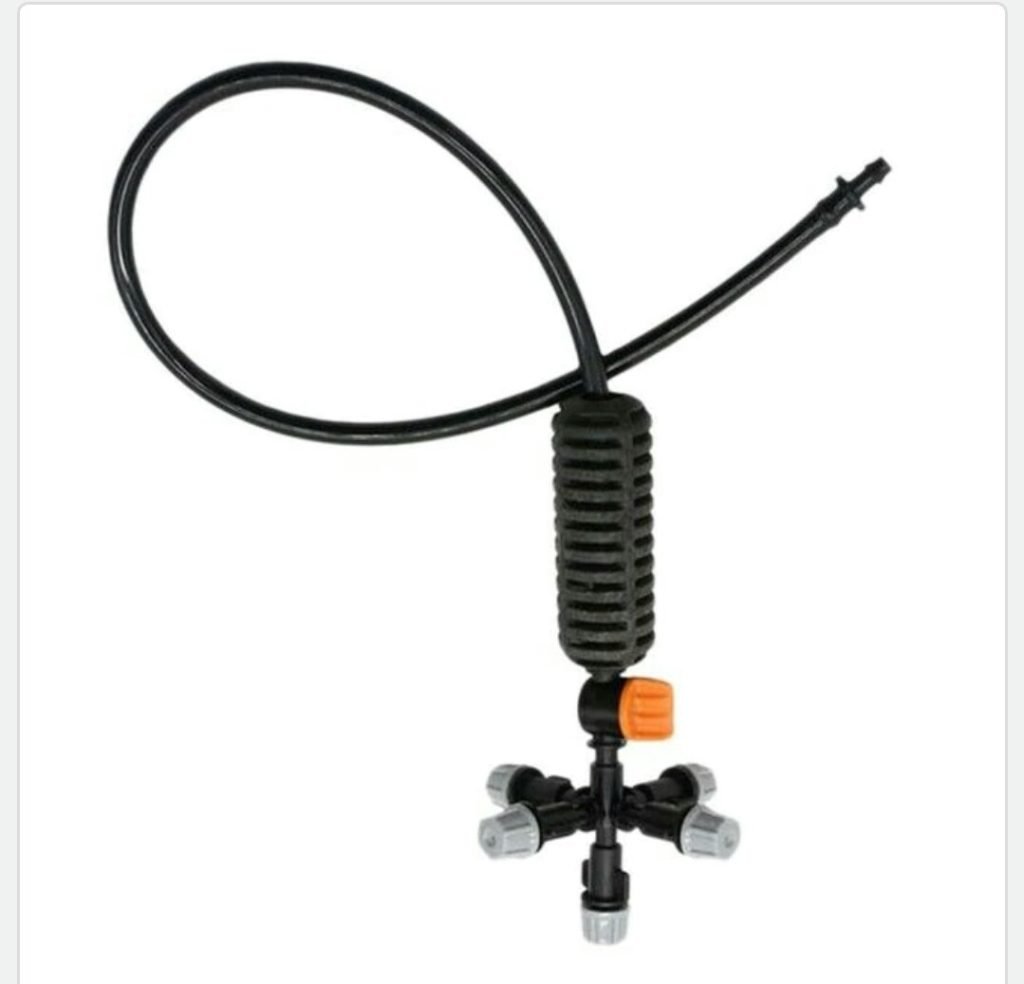
The FS consisted of a water softener and filters to prevent nozzle clogging, a water reservoir, pumps and a pressure regulator, and the FGNs. The main elements of the FS used in the plastic polyhouse. The FGNs were distributed uniformly over the plastic polyhouse. Three nozzle lines with 82 FGNs were installed in each span of the plastic polyhouse. At each nozzle line, 82 FGNs were uniformly located with 2.5 m nozzle spacing. The central water feed system was electrically operated depending on the relative humidity inside the plastic polyhouse.
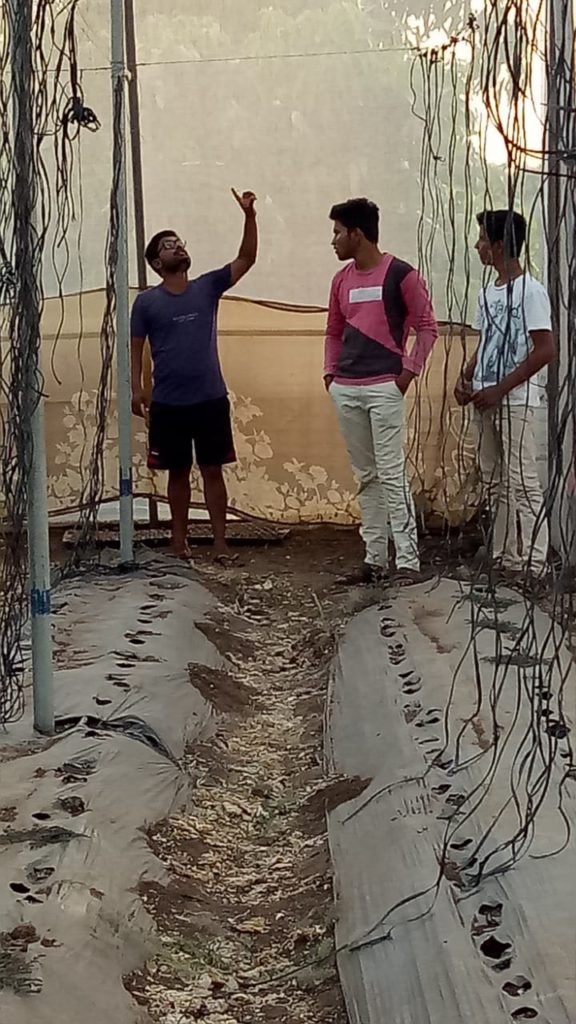
Fig Discussion on fogger system
The FG was operated to maintain 60% relative humidity during the day. The operation of the FS was controlled by a climate microcomputer connected to DBT and WBT sensors.
Meteorological measurements
A measuring system, including psychrometric units for measuring the WBT and DBT, was installed to control the operation of the FS. The WBT and DBT were measured on top of the canopy at 1.5 m from ground surface inside each span of the plastic polyhouse. The DBT and WBT of the inside air were measured by a Thies Clima ventilated psychrometer with PT 100 sensors at the centre of the span of the plastic polyhouse.
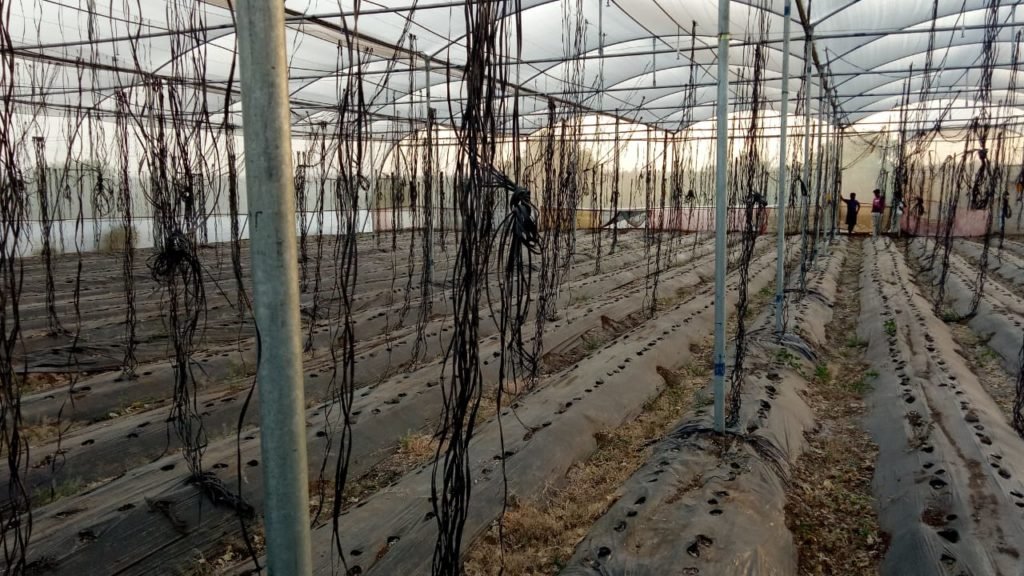
Fig.Internal stracture of polyhouse
The DBT and WBT of the outside air were measured at a height of 2.5 m at a distance of 12 m from the plastic polyhouse. The measurements of the global solar radiation (0.3−2.5 µm) outside the plastic polyhouse were taken at a height of 6 m above the soil surface at a distance of 12 m from the plastic polyhouse. The global solar radiation was measured by Li-Cor Silicium probes. The velocity and direction of the wind were also recorded with vector instruments. The measurements of the wind direction and wind speed were taken at a height of 10 m above the ground and at a distance of 12 m from the plastic polyhouse. The analogue signals from the sensors were sampled at 30 s intervals, averaged every 30 min and stored in a data-logger connected to the sensors.
Air flow rate
Based on the assumptions of a steady-state condition, and on the known desired temperature and the relative humidity in the polyhouse, the required AFR can be approximated by the following equation Fogging systems and evaporative cooling.
4. Results and discussion
The efficiency of the FS in the plastic Polyhouse was investigated, especially for the hottest recorded days in the experimental period. The air temperatures inside the plastic Polyhouse were compared with the outside air temperatures as important measures of the FS. From all the recorded climatic values, the results of the 3 consecutive days when the outside air temperatures are highest. The average hourly values of the 3 consecutive days for the outside and inside climatic conditions are summarised.
The air temperature inside the plastic Polyhouse decreased with increasing the sensible and latent heat transfer from the plastic greenhouse to the outside. Figure 2 shows that a substantial decrease in ambient air temperature inside the plastic Polyhouse occurred when the DBT outside the plastic Polyhouse exceeded 40°C. Under these conditions (air temperature of 40°C and relative humidity of 32.6%), the FS provided a cooling effect of 6.6°C
the absolute temperature difference (ATD) between the outside and inside. This good performance is due to the high efficiency of the FS (80%), Abdellatif (1993) found that the highest value of cooling effect (13.2°C) was achieved with the highest value of the wet bulb depression (16.2°C) and the lowest value of relative humidity (26%) and vice versa. Kittas et al. also succeeded in maintaining Polyhouse temperatures that The values of the inside and outside climate between 1 hours, and efficiency parameters during the 3 day testing period Climate parameters Minimum Maximum Average Outside solar radiation.
Conclusions:
The FS was able to keep the air temperature inside the plastic Polyhouse 6.6°C lower than that outside. Therefore, the relative humidity inside the plastic Polyhouse was increased by 25% on average by means of the FS examined in this study. It was found that the average efficiency of the FS was 50.5%. The relative humidity outside the plastic Polyhouse affected the FSE in this experiment. The efficiency of the FS increased when the outside relative humidity was lower. It is necessary to know the ventilation characteristics of a Polyhouse to provide good control of the inside environmental conditions, and a good crop yield of high quality produce
The FS was able to keep the air temperature inside the plastic Polyhouse 6.6°C lower than that outside. Therefore, the relative humidity inside the plastic Polyhouse was increased by 25% on average by means of the FS examined in this study. It was found that the average efficiency of the FS was 50.5%. The relative humidity outside the plastic Polyhouse affected the FSE in this experiment. The efficiency of the FS increased when the outside relative humidity was lower. It is necessary to know the ventilation characteristics of a Polyhouse to provide good control of the inside environmental conditions, and a good crop yield of high quality produce


